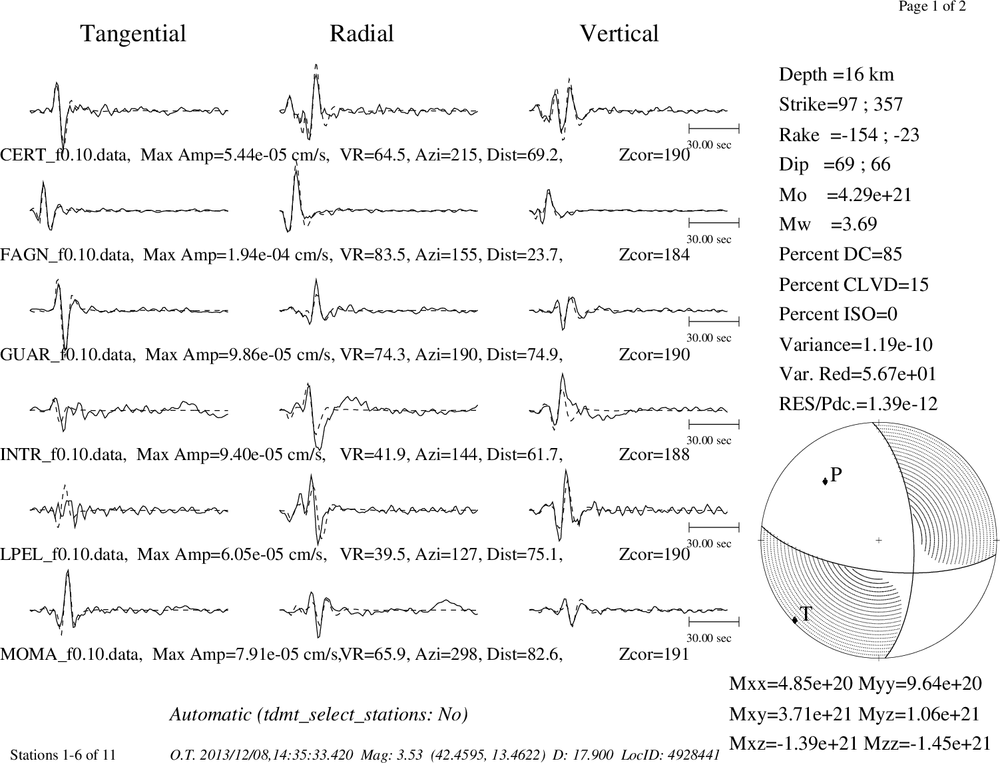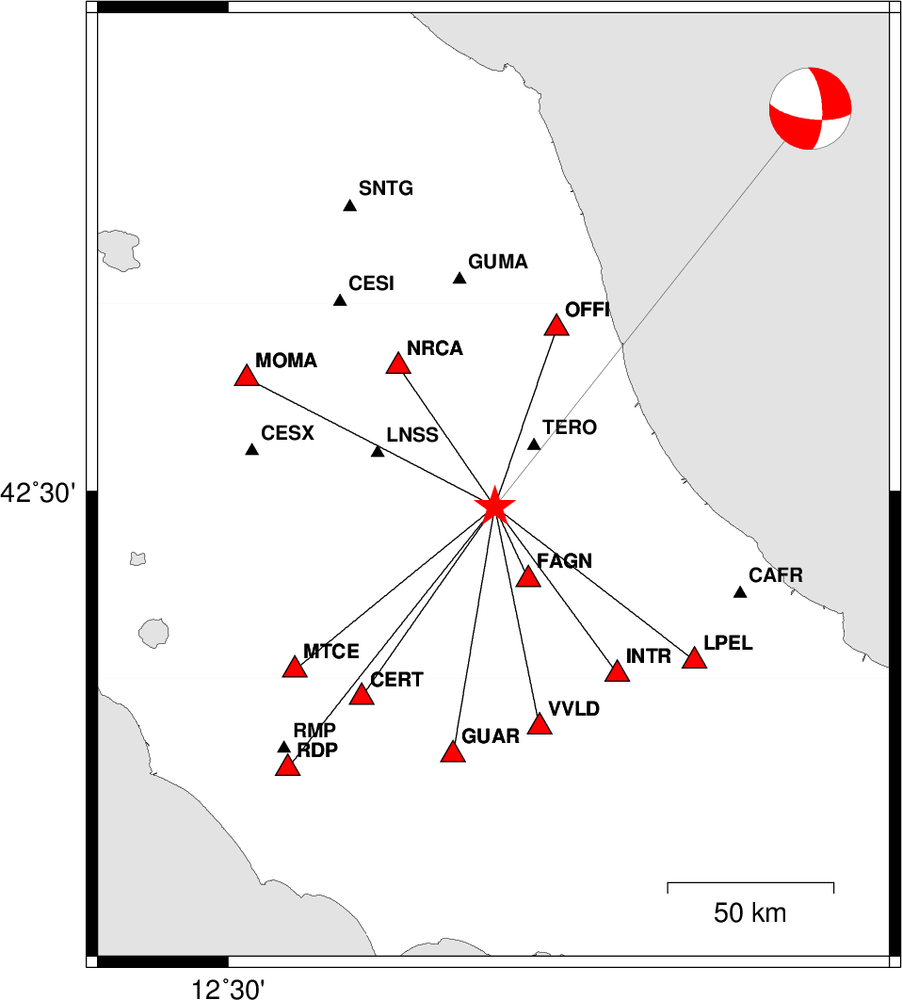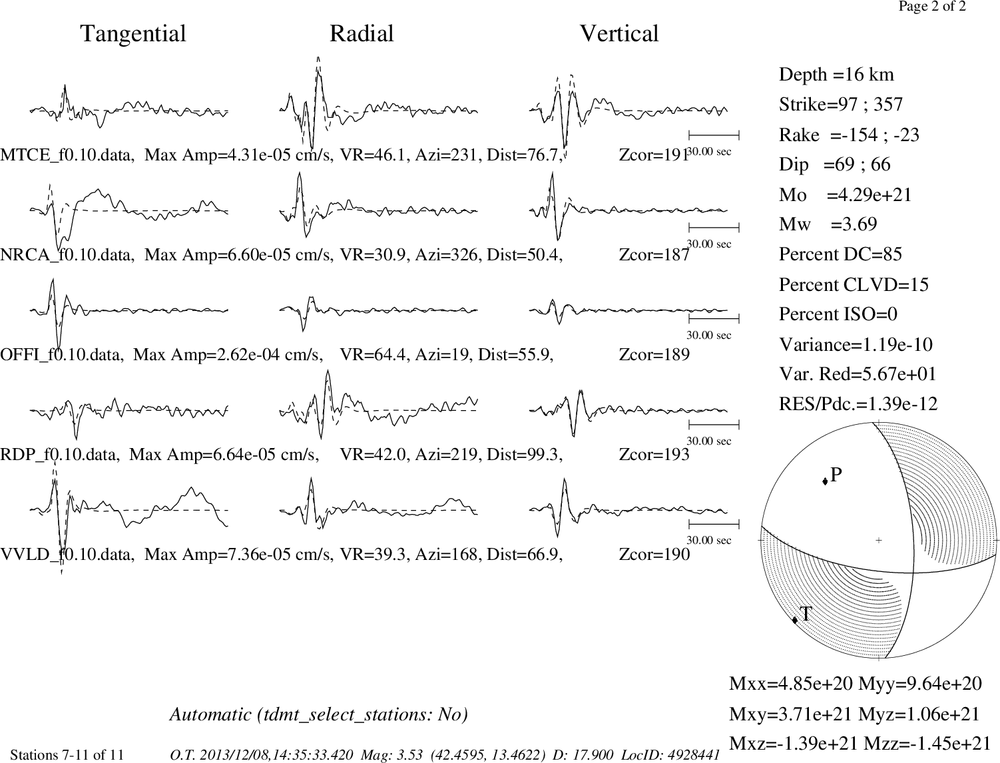Location
2013/12/08 14:35:33 42.459 13.462 17.9 3.50 Italy
Arrival Times (from USGS)
Arrival time list
Felt Map
USGS Felt map for this earthquake
USGS Felt reports page for
Focal Mechanism
SLU Moment Tensor Solution
ENS 2013/12/08 14:35:33:0 42.46 13.46 17.9 3.5 Italy
Stations used:
IV.ARVD IV.ASQU IV.BSSO IV.CAFI IV.CAFR IV.CASP IV.CERA
IV.CERT IV.CESI IV.CESX IV.CING IV.CRE IV.CSNT IV.FDMO
IV.FRES IV.FSSB IV.GIUL IV.GUAR IV.GUMA IV.INTR IV.LATE
IV.LAV9 IV.LNSS IV.LPEL IV.MA9 IV.MAON IV.MGAB IV.MIDA
IV.MODR IV.MSAG IV.MTCE IV.NRCA IV.OFFI IV.OSSC IV.PARC
IV.PESA IV.PIGN IV.POFI IV.PSB1 IV.PTQR IV.RNI2 IV.ROM9
IV.SACR IV.SACS IV.SAMA IV.SGRT IV.SNTG IV.SSFR IV.T0104
IV.TERO IV.TOLF IV.VAGA IV.VVLD MN.AQU
Filtering commands used:
cut a -10 a 100
rtr
taper w 0.1
hp c 0.02 n 3
lp c 0.10 n 3
Best Fitting Double Couple
Mo = 3.05e+21 dyne-cm
Mw = 3.59
Z = 13 km
Plane Strike Dip Rake
NP1 94 72 -154
NP2 355 65 -20
Principal Axes:
Axis Value Plunge Azimuth
T 3.05e+21 5 223
N 0.00e+00 58 126
P -3.05e+21 31 316
Moment Tensor: (dyne-cm)
Component Value
Mxx 4.58e+20
Mxy 2.63e+21
Mxz -1.15e+21
Myy 3.43e+20
Myz 7.75e+20
Mzz -8.00e+20
------########
------------##########
----------------############
------------------############
----- -------------#############
------ P -------------##############
------- --------------##############
-------------------------###############
--------------------------##############
---------------------------###############
#--------------------------###############
####-----------------------###############
#########-------------------###########---
####################------#-------------
##########################--------------
#########################-------------
########################------------
# ###################-----------
T ##################----------
##################---------
###############-------
##########----
Global CMT Convention Moment Tensor:
R T P
-8.00e+20 -1.15e+21 -7.75e+20
-1.15e+21 4.58e+20 -2.63e+21
-7.75e+20 -2.63e+21 3.43e+20
Details of the solution is found at
http://www.eas.slu.edu/eqc/eqc_mt/MECH.IT/20131208143533/index.html
|
Preferred Solution
The preferred solution from an analysis of the surface-wave spectral amplitude radiation pattern, waveform inversion and first motion observations is
STK = -5
DIP = 65
RAKE = -20
MW = 3.59
HS = 13.0
The NDK file is 20131208143533.ndk
The waveform inversion is preferred.
Moment Tensor Comparison
The following compares this source inversion to others
| SLU |
INGVTDMT |
SLU Moment Tensor Solution
ENS 2013/12/08 14:35:33:0 42.46 13.46 17.9 3.5 Italy
Stations used:
IV.ARVD IV.ASQU IV.BSSO IV.CAFI IV.CAFR IV.CASP IV.CERA
IV.CERT IV.CESI IV.CESX IV.CING IV.CRE IV.CSNT IV.FDMO
IV.FRES IV.FSSB IV.GIUL IV.GUAR IV.GUMA IV.INTR IV.LATE
IV.LAV9 IV.LNSS IV.LPEL IV.MA9 IV.MAON IV.MGAB IV.MIDA
IV.MODR IV.MSAG IV.MTCE IV.NRCA IV.OFFI IV.OSSC IV.PARC
IV.PESA IV.PIGN IV.POFI IV.PSB1 IV.PTQR IV.RNI2 IV.ROM9
IV.SACR IV.SACS IV.SAMA IV.SGRT IV.SNTG IV.SSFR IV.T0104
IV.TERO IV.TOLF IV.VAGA IV.VVLD MN.AQU
Filtering commands used:
cut a -10 a 100
rtr
taper w 0.1
hp c 0.02 n 3
lp c 0.10 n 3
Best Fitting Double Couple
Mo = 3.05e+21 dyne-cm
Mw = 3.59
Z = 13 km
Plane Strike Dip Rake
NP1 94 72 -154
NP2 355 65 -20
Principal Axes:
Axis Value Plunge Azimuth
T 3.05e+21 5 223
N 0.00e+00 58 126
P -3.05e+21 31 316
Moment Tensor: (dyne-cm)
Component Value
Mxx 4.58e+20
Mxy 2.63e+21
Mxz -1.15e+21
Myy 3.43e+20
Myz 7.75e+20
Mzz -8.00e+20
------########
------------##########
----------------############
------------------############
----- -------------#############
------ P -------------##############
------- --------------##############
-------------------------###############
--------------------------##############
---------------------------###############
#--------------------------###############
####-----------------------###############
#########-------------------###########---
####################------#-------------
##########################--------------
#########################-------------
########################------------
# ###################-----------
T ##################----------
##################---------
###############-------
##########----
Global CMT Convention Moment Tensor:
R T P
-8.00e+20 -1.15e+21 -7.75e+20
-1.15e+21 4.58e+20 -2.63e+21
-7.75e+20 -2.63e+21 3.43e+20
Details of the solution is found at
http://www.eas.slu.edu/eqc/eqc_mt/MECH.IT/20131208143533/index.html
|
|
Waveform Inversion
The focal mechanism was determined using broadband seismic waveforms. The location of the event and the
and stations used for the waveform inversion are shown in the next figure.

|
|
Location of broadband stations used for waveform inversion
|
The program wvfgrd96 was used with good traces observed at short distance to determine the focal mechanism, depth and seismic moment. This technique requires a high quality signal and well determined velocity model for the Green functions. To the extent that these are the quality data, this type of mechanism should be preferred over the radiation pattern technique which requires the separate step of defining the pressure and tension quadrants and the correct strike.
The observed and predicted traces are filtered using the following gsac commands:
cut a -10 a 100
rtr
taper w 0.1
hp c 0.02 n 3
lp c 0.10 n 3
The results of this grid search from 0.5 to 19 km depth are as follow:
DEPTH STK DIP RAKE MW FIT
WVFGRD96 1.0 180 90 -5 3.23 0.2947
WVFGRD96 2.0 10 60 25 3.34 0.3230
WVFGRD96 3.0 5 60 15 3.37 0.3402
WVFGRD96 4.0 5 60 10 3.40 0.3639
WVFGRD96 5.0 0 50 -5 3.46 0.3912
WVFGRD96 6.0 -5 55 -20 3.49 0.4158
WVFGRD96 7.0 355 60 -25 3.51 0.4411
WVFGRD96 8.0 355 65 -25 3.52 0.4681
WVFGRD96 9.0 355 65 -25 3.53 0.4871
WVFGRD96 10.0 -5 65 -25 3.55 0.5007
WVFGRD96 11.0 -5 65 -20 3.56 0.5092
WVFGRD96 12.0 -5 65 -20 3.58 0.5136
WVFGRD96 13.0 -5 65 -20 3.59 0.5146
WVFGRD96 14.0 -5 65 -20 3.61 0.5118
WVFGRD96 15.0 -5 65 -20 3.64 0.5095
WVFGRD96 16.0 -5 60 -20 3.64 0.5033
WVFGRD96 17.0 -5 60 -20 3.65 0.4955
WVFGRD96 18.0 0 60 -15 3.67 0.4865
WVFGRD96 19.0 0 60 -15 3.67 0.4766
WVFGRD96 20.0 0 60 -15 3.68 0.4656
WVFGRD96 21.0 0 60 -15 3.69 0.4541
WVFGRD96 22.0 0 55 -15 3.70 0.4425
WVFGRD96 23.0 0 55 -10 3.70 0.4313
WVFGRD96 24.0 0 55 -10 3.71 0.4204
WVFGRD96 25.0 0 55 -10 3.72 0.4097
WVFGRD96 26.0 0 55 -10 3.72 0.3998
WVFGRD96 27.0 0 55 -10 3.73 0.3904
WVFGRD96 28.0 0 60 -10 3.74 0.3822
WVFGRD96 29.0 0 60 -10 3.75 0.3765
The best solution is
WVFGRD96 13.0 -5 65 -20 3.59 0.5146
The mechanism correspond to the best fit is

|
|
Figure 1. Waveform inversion focal mechanism
|
The best fit as a function of depth is given in the following figure:

|
|
Figure 2. Depth sensitivity for waveform mechanism
|
The comparison of the observed and predicted waveforms is given in the next figure. The red traces are the observed and the blue are the predicted.
Each observed-predicted component is plotted to the same scale and peak amplitudes are indicated by the numbers to the left of each trace. A pair of numbers is given in black at the right of each predicted traces. The upper number it the time shift required for maximum correlation between the observed and predicted traces. This time shift is required because the synthetics are not computed at exactly the same distance as the observed and because the velocity model used in the predictions may not be perfect.
A positive time shift indicates that the prediction is too fast and should be delayed to match the observed trace (shift to the right in this figure). A negative value indicates that the prediction is too slow. The lower number gives the percentage of variance reduction to characterize the individual goodness of fit (100% indicates a perfect fit).
The bandpass filter used in the processing and for the display was
cut a -10 a 100
rtr
taper w 0.1
hp c 0.02 n 3
lp c 0.10 n 3

|
|
Figure 3. Waveform comparison for selected depth. Red: observed; Blue - predicted. The time shift with respect to the model prediction is indicated. The percent of fit is also indicated.
|

|
|
Focal mechanism sensitivity at the preferred depth. The red color indicates a very good fit to thewavefroms.
Each solution is plotted as a vector at a given value of strike and dip with the angle of the vector representing the rake angle, measured, with respect to the upward vertical (N) in the figure.
|
A check on the assumed source location is possible by looking at the time shifts between the observed and predicted traces. The time shifts for waveform matching arise for several reasons:
- The origin time and epicentral distance are incorrect
- The velocity model used for the inversion is incorrect
- The velocity model used to define the P-arrival time is not the
same as the velocity model used for the waveform inversion
(assuming that the initial trace alignment is based on the
P arrival time)
Assuming only a mislocation, the time shifts are fit to a functional form:
Time_shift = A + B cos Azimuth + C Sin Azimuth
The time shifts for this inversion lead to the next figure:

The derived shift in origin time and epicentral coordinates are given at the bottom of the figure.
Discussion
Velocity Model
The nnCIA used for the waveform synthetic seismograms and for the surface wave eigenfunctions and dispersion is as follows:
MODEL.01
C.It. A. Di Luzio et al Earth Plan Lettrs 280 (2009) 1-12 Fig 5. 7-8 MODEL/SURF3
ISOTROPIC
KGS
FLAT EARTH
1-D
CONSTANT VELOCITY
LINE08
LINE09
LINE10
LINE11
H(KM) VP(KM/S) VS(KM/S) RHO(GM/CC) QP QS ETAP ETAS FREFP FREFS
1.5000 3.7497 2.1436 2.2753 0.500E-02 0.100E-01 0.00 0.00 1.00 1.00
3.0000 4.9399 2.8210 2.4858 0.500E-02 0.100E-01 0.00 0.00 1.00 1.00
3.0000 6.0129 3.4336 2.7058 0.500E-02 0.100E-01 0.00 0.00 1.00 1.00
7.0000 5.5516 3.1475 2.6093 0.167E-02 0.333E-02 0.00 0.00 1.00 1.00
15.0000 5.8805 3.3583 2.6770 0.167E-02 0.333E-02 0.00 0.00 1.00 1.00
6.0000 7.1059 4.0081 3.0002 0.167E-02 0.333E-02 0.00 0.00 1.00 1.00
8.0000 7.1000 3.9864 3.0120 0.167E-02 0.333E-02 0.00 0.00 1.00 1.00
0.0000 7.9000 4.4036 3.2760 0.167E-02 0.333E-02 0.00 0.00 1.00 1.00
Quality Control
Here we tabulate the reasons for not using certain digital data sets
The following stations did not have a valid response files:
DATE=Sun Dec 8 16:04:14 CST 2013
Last Changed 2013/12/08








